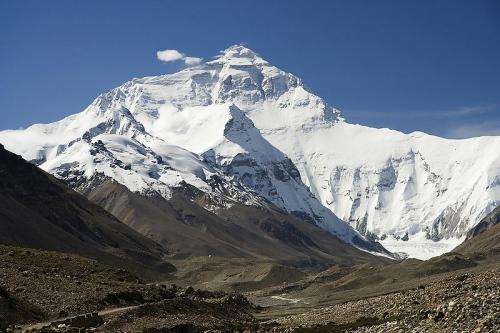Himalayan ice shows chemicals ban is working

A unique study of frozen ice cores from the Tibetan Himalayas has shown that international agreements on phasing out the use of toxic persistent organic pollutants are working.
The research paper in the leading American Chemical Society journal, Environmental Science & Technology has been named as the journal's most read paper of 2014.
Lancaster University scientists worked with colleagues from China and Germany to collect and analyse samples from ice cores which had been laid down over 30 years, to show how residues of Perfluoroalkyl substances (PFASs) in the environment have changed over time.
"PFASs are used in many everyday products such as fabric linings, non-stick pans and firefighting foams," said Dr Crispin Halsall from Lancaster University's Environment Centre.
"They are very persistent in the environment and some can accumulate in living things. Many of these compounds are thought to be toxic to humans: a recent study has shown very strong evidence that one, PFOA, retards human fetal growth.
"Chemical residues are carried thousands of miles on the prevailing winds and deposited in the ice. Ice cores are very effective barometers of pollution over time as ice is laid down over the decades. We wanted to see whether the level and type of these chemicals in the cores had changed over time."
It is much cheaper to test ice cores, which capture years of data in one core, than to do repeated air sampling over time. There are also advantages in testing in remote regions, far away from pollution sources, because samples are not distorted by local activities, and so the results provide a global picture.
The ice cores came from two sites: one on the eastern end of the Plateau where the prevailing wind comes from Asia, and the other on the western end with prevailing winds from Europe.
The results were fascinating: reflecting changes in policy and production of these chemicals in the different regions over time.
On the western side the ice cores showed deposits of PFASs initially increasing as they were used more and more in European industry in the 1980s, and then decreasing as industrial output changed in the early 2000s. One of these compounds is classed as a persistent organic pollutant under the UNEP Stockholm Convention and industry agreed, largely voluntarily, to phase out some of these compounds.
On the eastern side the level of residues is still increasing as Asia becomes more industrialised, but the nature of the PFASs are changing.
Dr Halsall said: "Some of the long carbon chain compounds are particularly toxic and industry has responded by producing shorter chain compounds, and we are starting to see that in the ice cores. Good practice in industry is having an impact.
"It provides the evidence that you can change things and reduce the prevalence of toxic chemicals through consensus and an international framework. That is very encouraging.
"I think the paper is so popular because it highlights that remote environments like The Tibetan Plateau can act as a barometer for assessing changes to global industrial output of these chemicals."
More information: Environmental Science & Technology 2014, 48 (1), pp 173–181. Publication Date (Web): December 9, 2013. DOI: 10.1021/es4044775
Journal information: Environmental Science & Technology
Provided by Lancaster University



















